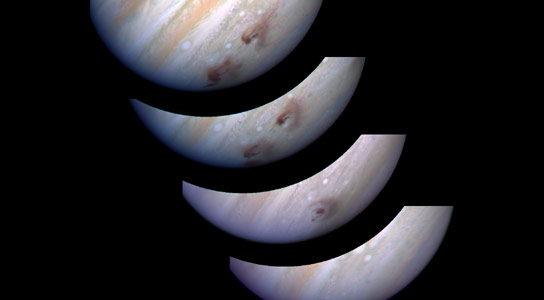
This mosaic of WFPC-2 images shows the evolution of the G impact site on Jupiter (the 21 comet fragments of Shoemaker-Levy 9 were each assigned a corresponding letter to identify the impact site; G represents the 7th fragment to strike the planet. It was also the largest impact.).
The images from lower right to upper left show: the impact plume at 07/18/94 07:38 UT (about 5 minutes after the impact); the fresh impact site at 07/18/94 at 09:19 UT (1.5 hours after impact); the impact site after evolution by the winds of Jupiter (left), along with the L impact (right), taken on 07/21/94 at 06:22 UT (3 days after the G impact and 1.3 days after the L impact); and further evolution of the G and L sites due to winds and an additional impact (S) in the G vicinity, taken on 07/23/94 at 08:08 UT (5 days after the G impact). Credit: R. Evans, J. Trauger, H. Hammel and the HST Comet Science Team
Using the Herschel space observatory, researchers have solved the mystery as to the origin of water in the upper atmosphere of Jupiter, finding conclusive evidence that it was delivered by the impact of comet Shoemaker-Levy 9 in 1994.
Astronomers have finally found direct proof that almost all water present in Jupiter’s stratosphere was delivered by comet Shoemaker-Levy 9, which struck the planet in 1994. The result is based on new data from Herschel that revealed more water in Jupiter’s southern hemisphere, where the impacts occurred, than in the north as well as probing the vertical distribution of water in the planet’s stratosphere.
The origin of water in the upper atmospheres of the Solar System’s giant planets has been debated for almost two decades. Astronomers were quite surprised at the discovery of water in the stratosphere – an intermediate atmospheric layer – of Jupiter, Saturn, Uranus and Neptune, which dates to observations performed with ESA’s Infrared Space Observatory (ISO) in 1997. While the source of water in the lower layers of their atmospheres can be explained as internal, the presence of this molecule in their upper atmospheric layers is puzzling due to the scarcity of oxygen there – its supply must have an external origin. Since then, astronomers have investigated several possible candidates that may have delivered water to these planets, from icy rings and satellites to interplanetary dust particles and cometary impacts.
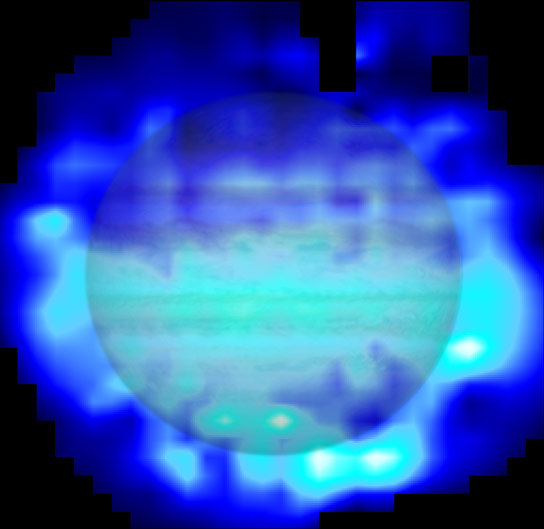
This map shows the distribution of water in the stratosphere of Jupiter as measured with ESA’s Herschel Space Observatory. White and cyan indicate the highest concentration of water, and blue indicates lesser amounts. The map has been superimposed over an image of Jupiter taken at visible wavelengths with the NASA/ESA Hubble Space Telescope.
The distribution of water clearly shows an asymmetric distribution across the planet’s disc: water is more abundant in the southern hemisphere. Based on this and other clues collected with Herschel, astronomers have established that at least 95 percent of the water currently present in Jupiter’s stratosphere has been supplied by comet Shoemaker-Levy 9, which famously impacted the planet at intermediate southern latitudes in 1994.
The map is based on spectrometric data collected with the PACS instrument on board Herschel around 66.4 microns, a wavelength that corresponds to one of water’s many spectral signatures. Credit: ESA/Herschel/T. Cavalié et al.; Jupiter image: NASA/ESA/Reta Beebe (New Mexico State University)
Answers are now starting to flow in from studies using ESA’s Herschel Space Observatory. Herschel boasts unprecedented sensitivity as well as high spatial and spectral resolution at the far-infrared wavelengths, where many water emission lines can be observed. In 2011, a study based on Herschel data indicated that water in the stratosphere of Saturn is provided by its icy moon Enceladus; in 2012, the same origin was suggested for water in the atmosphere of Titan, another of Saturn’s moons. Now it’s the turn of Jupiter.
Soon after ISO’s results, astronomers suspected that stratospheric water on Jupiter may have been, at least in part, supplied by comet Shoemaker-Levy 9, whose fragments famously hit the planet in July 1994. Until now, the claims were based on indirect evidence, such as the observations of carbon dioxide (CO2), which can be produced from the photo-chemistry of water; but the new Herschel data have yielded the long-sought direct proof.
“We have been eagerly looking forward to observing Jupiter with Herschel,” comments Thibault Cavalié from the Laboratoire d’Astrophysique de Bordeaux, France, who led the study.
“Herschel has a unique combination of instruments that allowed us to perform a three-dimensional reconstruction of water in Jupiter’s stratosphere: using PACS, we could map the distribution of water across the entire disc of the planet, and we probed the vertical profile of water in the stratosphere using HIFI. The combination of both data sets was crucial to linking the source of water to the famous cometary impact of almost 19 years ago,” he adds.
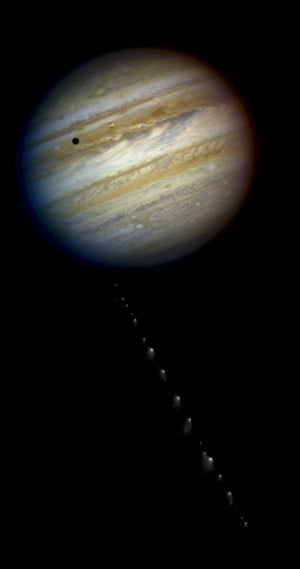
This is a composite photo, assembled from separate images of Jupiter and comet Shoemaker-Levy 9, as imaged by the NASA/ESA Hubble Space Telescope in 1994. Credit: NASA, ESA, H. Weaver and E. Smith (STScI) and J. Trauger and R. Evans (Jet Propulsion Laboratory)
Cavalié and his colleagues collected their first observations of Jupiter with PACS during Herschel’s Science Demonstration Phase in late 2009, obtaining a set of spectra that coarsely spanned the planet’s disc.
“The first observations were not yet optimized for the purpose of our study, but they already showed an asymmetric distribution of stratospheric water across Jupiter’s disc. This first hint that water is overly abundant in the southern hemisphere motivated the rest of our observations,” explains co-author Paul Hartogh of the Max-Planck-Institut für Sonnensystemforschung (MPS) in Katlenburg-Lindau, Germany. Hartogh is the Principal Investigator of the Herschel Key Program ‘Water and Related Chemistry in the Solar System’ within which the observations were performed. “After all, Shoemaker-Levy 9 hit Jupiter at intermediate southern latitudes.”
In 2010, the astronomers observed Jupiter again with PACS, this time gathering spectra at a much larger number of points across the planet’s disc. This enabled them to obtain an accurate map of Jupiter’s emission at 66.4 microns, a wavelength that corresponds to one of water’s many spectral signatures. A comparison of this map with mid-infrared data from NASA’s Infrared Telescope Facility (IRTF) that probe the atmospheric temperature indicated that the asymmetry in the water emission detected with Herschel is not linked to temperature fluctuations and must be due to an uneven distribution of water around the planet.
“The asymmetry between the two hemispheres suggests that water was delivered during a single event and rules out icy rings or moons as candidate sources,” says Cavalié. “Local sources would provide a steady supply of water, which over time would lead to a hemispherically symmetric distribution in the stratosphere. Depending on whether the chemical species are transported in neutral or ionized form, local sources of water would result in higher concentrations either at the poles or along the equator, but not in a north-south asymmetry,” he adds.
The PACS data, which enabled the astronomers to collect spectra across Jupiter’s disc at great spatial resolution, were complemented with a set of high spectral resolution measurements from HIFI. Taken at 25 points across the planet’s disc, these spectra were centered at 179.5 microns, another wavelength corresponding to an emission line of the water molecule.
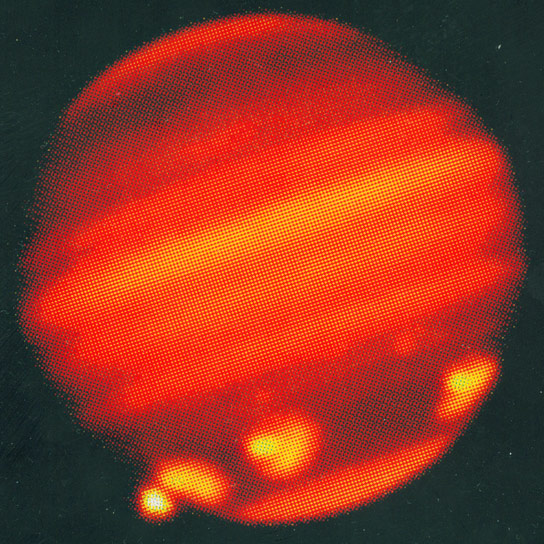
This image shows Jupiter after its impact with comet Shoemaker-Levy 9, which hit the planet at intermediate southern latitudes in July 1994. The image was taken on 20 July 1994 at near-infrared wavelengths with the infrared camera MAGIC at the 3.5-m telescope at the German-Spanish Calar Alto Observatory. At the lower left rim of the planet, the explosion cloud produced by the impact of one of the last fragments of the comet can be seen. The bright spots to its right are the hot traces left by impacts of other fragments. Credit: Calar Alto Observatory/Max Planck Institute for Astronomy, Heidelberg, Germany
“Exploiting the high spectral resolution of HIFI data, we could probe the vertical distribution of water across Jupiter’s stratosphere,” explains Hartogh, “This was our ‘smoking-gun’ proof to exclude other possible sources and confirm that at least 95 percent of the water currently present in Jupiter’s stratosphere was brought there by comet Shoemaker-Levy 9.”
The HIFI spectra indicate that the bulk of water is confined to pressures lower than 2 millibars, corresponding to high stratospheric altitudes – well above the uppermost part of the troposphere. The troposphere lies below the stratosphere, in Jupiter’s lower atmosphere, and its uppermost layer can be regarded as the visible planetary ‘surface’. This part of the troposphere is also referred to as the ‘cold trap’ because it prevents water vapor from below to rise into the stratosphere, where it would condense into ice due to the low temperatures. For this reason, any trace of water in the stratosphere must have been delivered from an external source. Furthermore, the absence of water in the lower stratosphere pinpoints the origin of this water to a sporadic event: had it been brought by interplanetary dust particles, it would have had more time to be redistributed throughout the stratosphere and its vertical distribution would have extended to much lower altitudes.
The results do not exclude that interplanetary dust particles, icy rings and satellites or other cometary impacts may have brought water to Jupiter’s stratosphere, but only in marginal amounts compared to that supplied by the 1994 impact.
“As the bulk of water we see in Jupiter’s stratosphere was delivered at a single time in the past, we expect its content to slowly decline over the years, and we plan to keep monitoring Jupiter with the Swedish-led Odin spacecraft to study this decrement,” says Cavalié.
Significant amounts of water will still be present in the planet’s stratosphere by the 2030s, when ESA’s Jupiter Icy moons Explorer (JUICE) mission will reach the Jovian system. Among other goals, the mission’s Sub-millimeter Wave Instrument (SWI) will target a variety of molecules – including water – as tracers to study the circulation, winds, and other phenomena in Jupiter’s atmosphere.
“We are now certain that most water currently present in Jupiter’s stratosphere is a remnant of the spectacular 1994 break-up and subsequent impact of comet Shoemaker-Levy 9,” comments Göran Pilbratt, Herschel Project Scientist at ESA. “After showing that the water in Saturn’s stratosphere, and possibly also in the atmosphere of Titan, is being provided by the moon Enceladus, Herschel has now clarified its origin in the largest of the giant planets, painting a diverse picture of the history of water in the Solar System.”
Reference: “Spatial distribution of water in the stratosphere of Jupiter from Herschel-HIFI and PACS observations” by T. Cavalié, H. Feuchtgruber, E. Lellouch, M. de Val-Borro, C. Jarchow, R. Moreno, P. Hartogh, G. Orton, T. K. Greathouse, F. Billebaud, M. Dobrijevic, L. M. Lara, A. González and H. Sagawa, 23 April 2013, Astronomy & Astrophysics.
DOI: 10.1051/0004-6361/201220797
Images: R. Evans, J. Trauger, H. Hammel and the HST Comet Science Team; ESA/Herschel/T. Cavalié et al.; Jupiter image: NASA/ESA/Reta Beebe (New Mexico State University); NASA, ESA, H. Weaver and E. Smith (STScI) and J. Trauger and R. Evans (Jet Propulsion Laboratory); Calar Alto Observatory/Max Planck Institute for Astronomy, Heidelberg, Germany


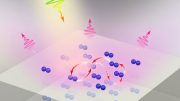


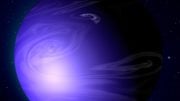


While it’s a known fact that comets carry water and the data provides a convincing link to Shoemaker-Levy 9 as the cause of the excess water in Jupiter’s upper atmosphere is it possible that a portion of a differentiated layer of water was ‘splashed’ up from depth when the impact punched through the Tropospheric ‘cold trap’?
Citation:A typical condensation hologram is operative as any planet moves through:All water present in Jupiter’s stratosphere was delivered by comet Shoemaker-Levy 9, which struck the planet in 1994. This not correct as Jupiter moves about in elastically space surrounding solar sum it collects by its spin pole activity ionise for condensation The chemical elements in water, hydrogen and oxygen, are some of the most abundant elements in the universe. Astronomers see the signature of water in giant molecular clouds between the stars, in disks of material that represent newborn planetary systems, and in the atmospheres of giant planets orbiting other stars. There must be water ejection domains at a distance from the planetary boundary such as water vapors that my be condensed and drawn into forming ocean on planetary boundaries. thought to have an ocean of liquid water beneath their surface in contact with mineral-rich rock, and may have the three ingredients needed for life as we know it: liquid water, essential chemical elements for biological processes, and sources of energy that could be used by living things but sometimes early atmosphere was stripped away by the wind of charged particles that streams from the sun, causing the planet to dry out.
For example more water will be collected by the Jupiter boundary as it moves through cance region of water affined sector by crab spin dynamics split up dynamics that oscillate between photon condensation as boson condensation in the for m of crab dynamics that squeeze and expand in between.This will be varying as it moves through scorpion ansd Pisces and mya be dried out as it moves through capricorn